
 The newsletter of NASA's Radio JOVE Project
The newsletter of NASA's Radio JOVE Project"Solar and Planetary Radio Astronomy for Schools"

 The newsletter of NASA's Radio JOVE Project
The newsletter of NASA's Radio JOVE Project

St. Mary’s Astronomy Research Team Specialist or SMARTS is a high school astronomy club in Medford, Oregon. Every year the club participates in a project such as double star observations, Lunar and Planetary Institute’s High School research program, or NITARP (NASA/IPAC teacher Archive Research Program). While talking to a team member from our NITARP project one of our club members learned about the Radio Jove project. We did some research and decided to build a receiver and antenna for the 2013-2014 school year. Four students took charge of building the receiver, but everyone celebrated at the end of the year club party with the successful initial run and data collection of our telescope. Building the receiver was extremely educational. We were glad the Radio Jove group had members that could fix our two mistakes on the circuit board. Meeting Chuck Higgins at the American Astronomical Society (AAS) conference in Washington, DC put a face to the project. It was fun to be involved in the teleconferences. Since our telescope had yet to be built during the Jupiter season, having the opportunity to listen to the noise picked up by other telescopes and have someone explain what we were seeing and hearing was great! We learned a lot on those occasions.
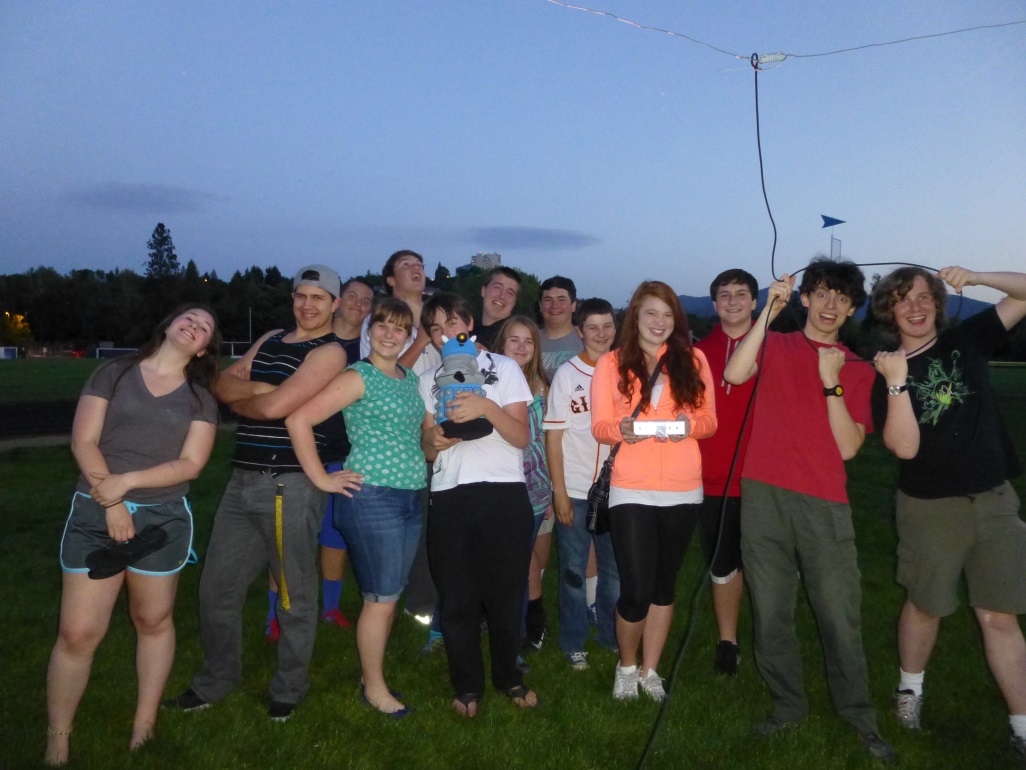
In July one of my students and I took the Radio Jove telescope to Pine Mountain Observatory for a 5 day high school research workshop. This was the first time a radio telescope made an appearance at the workshop. It was a successful week for us. We could run it when it was cloudy, when the sun was out, and when it was raining. The individuals with the optical telescopes fought the weather. David Haworth was there to lend some much needed advice on reading the squiggly lines and confirming our results with other, reliable sources. One of the other high school teachers from the workshop is seriously thinking about building a Radio Jove telescope after seeing our telescope in action.
Our next step is to collect more data and perhaps catch some Jupiter/Io storms this year.
In December 2013, Dave Typinski recorded a nighttime spectrogram with some ghostly sweeping features. Discussion with the Radio Jove Spectrograph Users Group (SUG) suggested that these features might be the result of a geomagnetic disturbance.[1] In October 2014, Typinski noticed similar features appearing again in his spectrograms. There were more discussions within the SUG of these “weird nighttime events” or WNEs. Thomas Ashcraft and Wes Greenman also started noticing them in their spectrograms. We all scratched our heads. While the sun was rather active there were no coronal mass ejection (CME) impacts on earth. “What are these things?” we all wondered.
Ashcraft suggested that maybe we were seeing Cassiopeia A (Cas A) or Cygnus A scintillation. He had noted the similarity of the WNEs to scintillation events observed by the KAIRA research instrument in Finland.[2] Dr. Francisco Reyes suggested that Typinski’s 8-element array be steered north toward Cas A, when this was done on October 30 the sweeping features appeared much stronger. The mystery was solved: the WNEs were really Cas A scintillation.
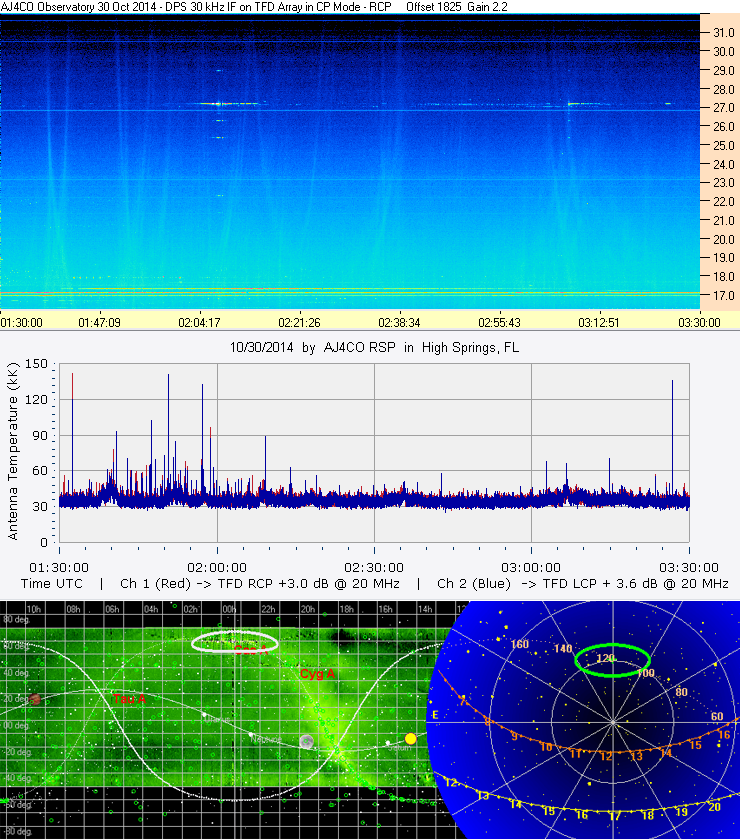
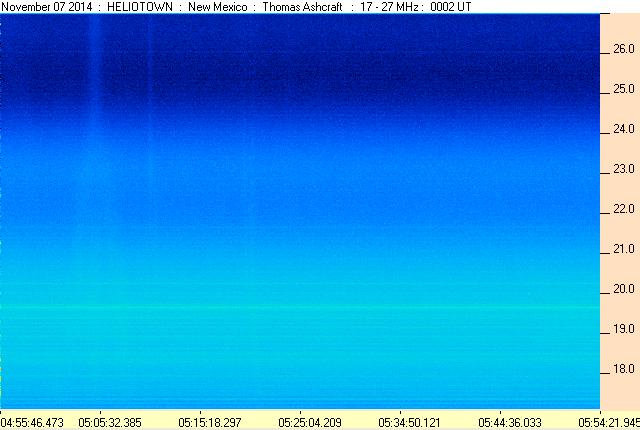
Cassiopeia A is a supernova remnant roughly 11,000 light years away. It is the strongest radio source outside our solar system, with a 20 MHz flux density of 65,000 Janskys, similar in strength to weak Jovian emission. We can just barely see it with a spectrograph and a Jove antenna because of propagation effects which cause the signal to vary in amplitude (scintillate). Even with Typinski’s 8-element array and a Jove receiver the fluctuations were barely visible in SkyPipe above the galactic background during the Oct 30 observation (Figure 1).
Stars twinkle because of turbulence in the earth’s atmosphere. This turbulence causes changes in the refractive index along the light’s propagation path. Point radio sources scintillate for the same reason. Much of this effect occurs in the earth’s ionosphere. Drifting clumps of electrons within the ionosphere can act like lenses, briefly focusing energy on our radio telescope antenna. This is what causes the nearly vertical ghostly streaks in our spectrograms. These streaks are not perfectly vertical because ionospheric effects are frequency dependent – at any given time, a good ionospheric lens for Cas A at one frequency may not be so good at another frequency.
A disturbed ionosphere can cause the observed scintillation. High solar activity or a CME impact will stir up the ionosphere. However, sometimes when the Sun is active, Cas A scintillation is not observed. The fine structure and variability of the ionosphere with solar activity is very much a field of current research. Cas A scintillation is one probe of the ionosphere’s dynamics.
An expanded version of this article is available at the Radio Jove
Library at
http://radiojove.gsfc.nasa.gov/library/pubs.htm
[1] http://www.radiojove.org/SUG/
[2] http://kaira.sgo.fi/2012/10/ionospheric-scintillation-with-kaira.html
IEEE Young Professionals Southern Alberta Section (SAS) with their STAR (Students, Teachers and Researchers) initiative in collaboration with Astronomy Teacher Training Institute (ATTI) are bringing greater awareness of Radio and Microwave technology to students in Alberta. ATTI is a non-profit organization founded by Mr. Tushar Sharma (Chairperson IEEE Young Professionals SAS) with an aim of popularizing science among high school students. Through this initiative the Society of Amateur Radio Astronomers (SARA) awarded a grant to the University of Calgary students in the form of a Radio Jove kit. Upon receiving this kit, two of the university students from the Electrical and Computer Engineering department, Mr. Dhruv Rijo (2nd year undergraduate) and Ms. Sara Awara (3rd year undergraduate), assembled the receiver and simulated the antenna for performance optimization under the guidance of Mr. Sharma and Mr. Anis Arfi, a second year graduate student at the iRadio laboratories, University of Calgary, Canada.
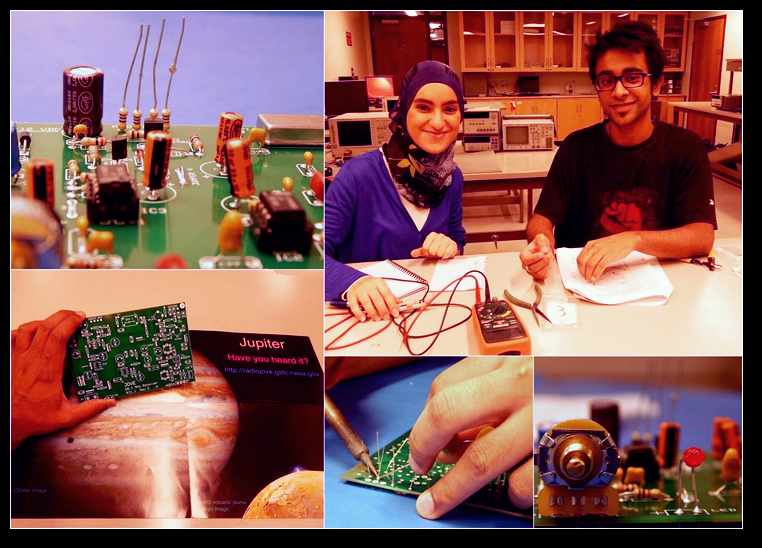
The team is looking into whether they can optimize the Radio Jove antenna They have focused their efforts on studying different antennas in a search for a smaller antenna that will yield suitable results. With the help of Mr. Sharma and Mr. Arfi they learned soldering techniques and successfully built the Jove receiver kit. After soldering the receiver, next was the testing stage during which they looked into areas of potential improvement. Using the 'Numerical Electromagnetics Code’ (NEC2) software, the team of four simulated the electromagnetic response of different types of antennas like dipole, loop, helix etc. for their project specifications. All the antennas were optimized for 20.1 MHz frequency, the frequency used by the Radio Jove program.
Currently, they are working on a comparative study for the loop design and observing the effects of varying different parameters of the design, such as the height of the loop above the ground, radii of the coupling loop and outer loop, capacitance used for tuning, types of material used, etc. Believing that every possible change will have an effect on the antenna performance, their aim is to document as many of these effects as possible and relate them to the antenna performance to obtain an optimized design. Furthermore the group will make simultaneous observations of Jupiter with the real Jove dual dipole antenna and the optimized loop to check on the validity of the loop model. Results will be published in a future Jove Bulletin.
The team hopes to build a continuing education center at Siksika, Alberta. As a part of this project they plan to provide hands-on training in astronomy including optical and radio telescope building and antenna design. Their planned teaching method would include using story-telling to impart knowledge. The Young Professionals hope to include a wide segment of the population so that the next generation can be made more aware of the wonders of science. We would like to thank SARA, Mr. Bruce Rout, Dr. James Thieman, Dr Deborah Scherrer, Professor Fadhel Gahnnouchi and Dr. Ramzi Darraji for their help and guidance throughout this motivational journey!!
A radio spectrogram displays signal strength (as different colors) on the frequency-time plane. Usually the colors are chosen so that blue is weak and red is strong. The images below are generated by a special receiver, which steps rapidly thru hundreds of frequencies – dwelling briefly at each frequency and measuring signal strength. The horizontal axis is universal time and the vertical axis is frequency in MHz. Several Jove stations stream spectrograph data in real time over the internet which can be viewed with Jim Sky’s free software available at http://jupiter.wcc.hawaii.edu/spectrograph_software.htm Observers using a Jove receiver can benefit from viewing these real time spectrograms as an aid to seeing what is happening at their observing frequency as well as other frequencies.
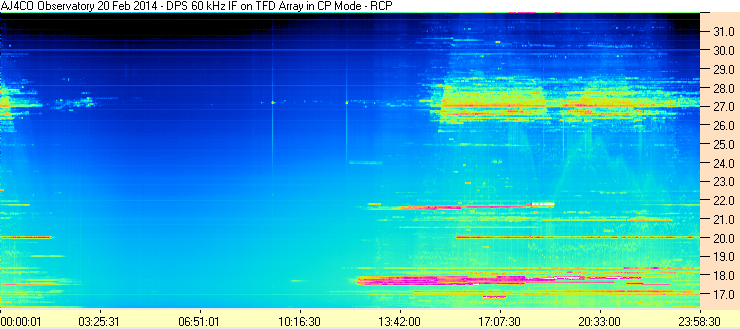
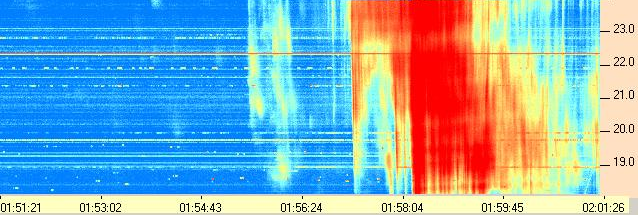
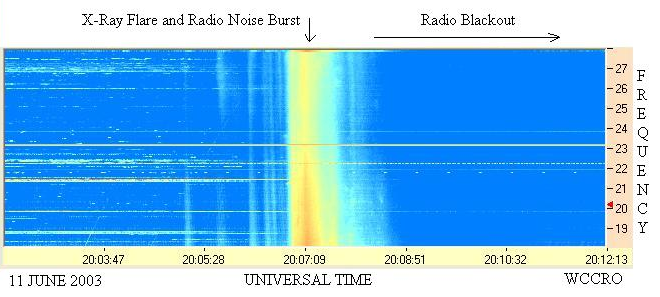
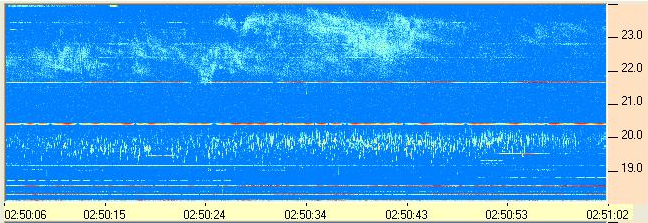
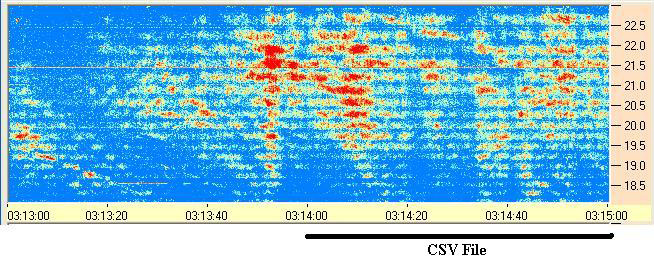
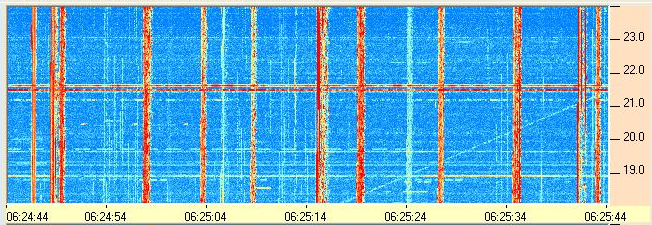
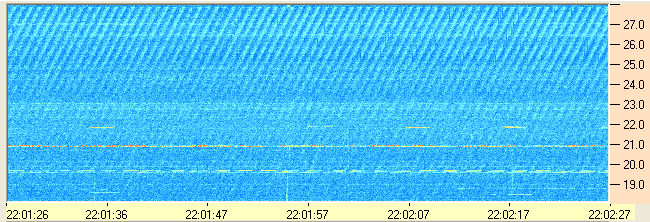
The Astronomical League in cooperation with the National Radio Astronomy Observatory has established a new observing program for radio astronomy. Participants in the Radio Astronomy Observing Program can win Bronze, Silver, or Gold level certificates based on their observations in certain categories.
These categories are:To win the Silver or Gold level awards you must be a member of the Astronomical League. Observers are expected to be actively involved in making the observations, observing streaming data from a remote observatory does not qualify for an award.
For more details and requirements of this award program visit:
http://www.astroleague.org/programs/radio-astronomy-observing-program
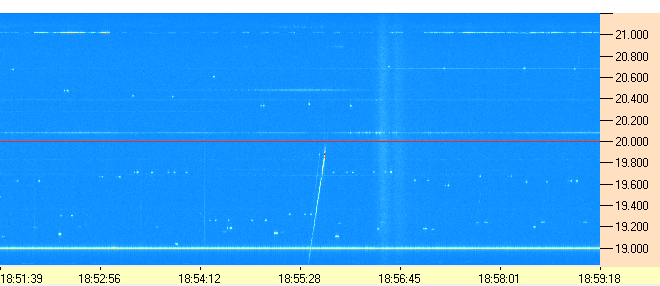
Some readers may have heard of using a USB TV receiver dongle as an inexpensive way to listen to radio signals over a wide range of frequencies. These thumb drive sized devices were intended for watching TV on your computer, but thanks to some wonderful reverse engineering by the people at Osmocom.com, the dongles are now widely used as radio receivers. I have written a small application called RTL Bridge that will allow you to connect one of these devices to Radio-SkyPipe (RSP) and Radio-Sky Spectrograph (RSS) software. With the latter program, you can see up to 2.4 MHz of spectrum. While this is not as useful as our 10 MHz wide spectrographs, it is instructive and is certainly a very affordable project. To listen down below 25 MHz you will need an “upconverter” which will accept signals from 0 to 30 MHz and convert them to a higher frequency that falls in the dongle receiver's range. Some marketers are now packaging the receivers with an upconverter for about $50 or $60. You will see a bunch on ebay. You need a dongle with an R820T tuner and RTL 2832 digital receiver chip. Sensitivity may be a problem with some devices. I cannot vouch for any one brand or vendor. Most dongle receivers accept something other than a BNC or F connector so remember to get an adapter for the antenna coax. You won't need a different antenna. Your Jove Dual Dipole will have plenty of bandwidth for a 2 MHz spectrum. To use these receivers with the Radio-Sky programs above, you will need to follow the instructions from my website: http://radiosky.com/spec/RTL_Bridge_Help.html
I have yet to see Jupiter on one of these receivers as I am currently located in a very noisy environment. However, Dave Cohen has caught a solar flare using a dongle and RSS ( Figure 1) and I hope to see a Jupiter spectrum from one of our Radio Jove participants very soon. There are several pieces to this project, hardware and software. I advise it for people who already have a working Jove observatory and are not just starting out. We don't know how well this works yet, if at all, so please follow the path well-traveled if you are just beginning, and save this project as a reward for overcoming the hurdles ahead.
I am the principal investigator of an educational project to increase access by young people to space resources. This program will run for three years and was just accepted by the Japanese Ministry of Education.
The project includes the development by our college students of two small satellites (CubeSats). One of the satellites will be the RadioJOVE satellite for fundamental testing of space-based Jupiter radio VLBI (Very Long Baseline Interferometry). I hope this program will contribute to the RadioJOVE project.
Professor and Dr. Kazumasa Imai
Department of Electrical Engineering and Information Science
Kochi National College of Technology, Japan
NASA/Goddard Space Flight Center produced a video explaining the
difference between solar flares (sudden flashes of X-rays and
other forms of radiation and particles) and Coronal Mass
Ejections (huge clouds of plasma ejeted at high speed from the
Sun). Each of them can produce dramatic effects at the Earth. To
learn more visit:
http://www.nasa.gov/content/goddard/the-difference-between-flares-and-cmes/index.html
In this issue we present a few new additions to our album of Radio Jove dipoles. Along with the Radio Jove dipole sighting in Bend, Oregon (article 1), Ferenc Puskas sends us a photo of his Radio Jove installation in Hungary.
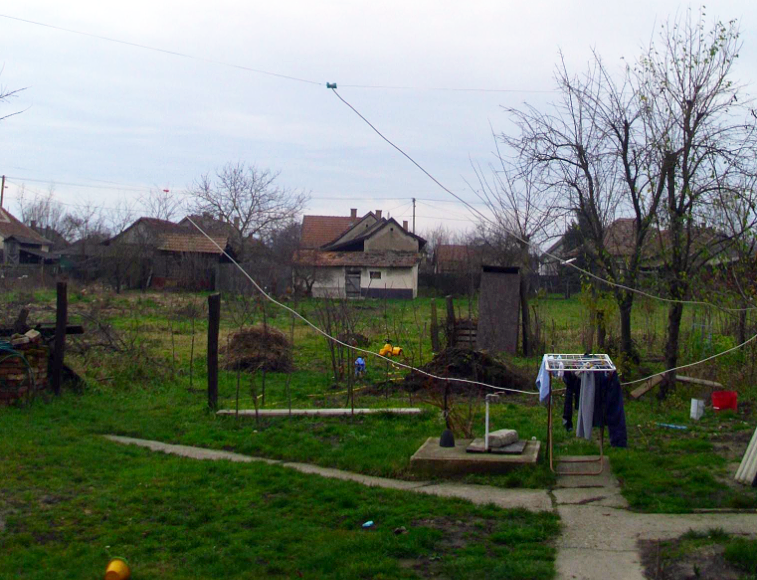
Terry Schmidt has his Radio Jove system set up in northern Minnesota.
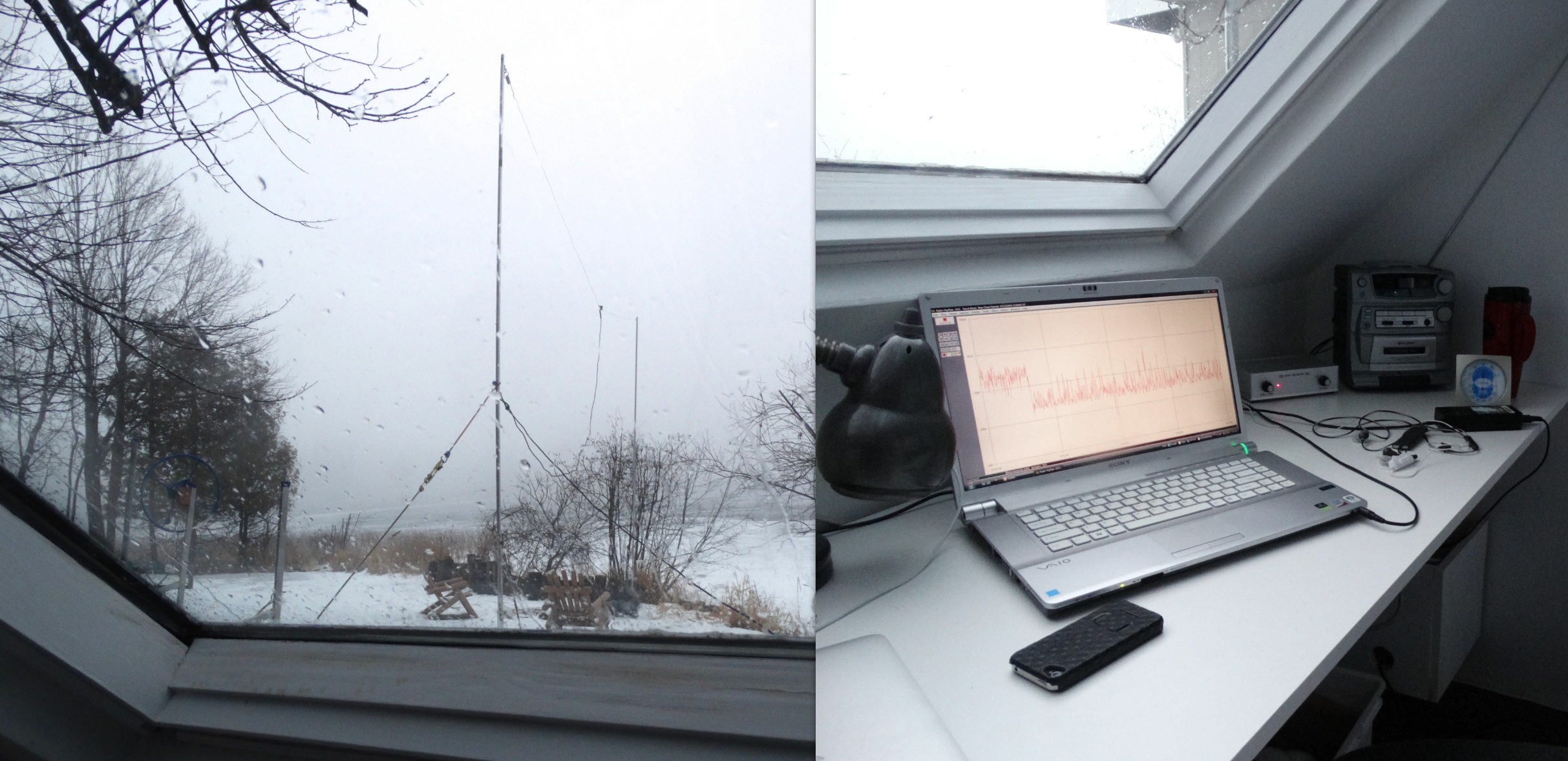
These join other illustrious dipoles seen in
The JOVE Bulletin is published twice a year. It is a free service of the Radio JOVE Project. We hope you will find it of value. Back issues are available on the Radio JOVE Project Web site, http://radiojove.gsfc.nasa.gov/
For assistance or information send inquiries to:
or
